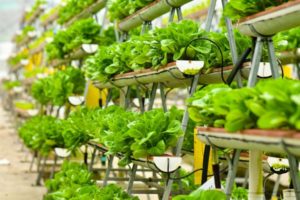
Many countries around the world – including India – have seen tremendous growth in vertical farming due to the technology’s potential to solve one of the most pressing problems: food security. These vertical farms could be installed in densely populated areas where they could supply fresh, healthy food to millions of people all year long, regardless of weather conditions.
Agri-production in India is constantly threatened by soil degradation, desertification, and extreme weather conditions such as floods and droughts. As a result, alternative farming methods such as vertical farming are becoming more popular.
Several startups and vertical farming companies are already operating in India, attempting to supply major cities with locally grown produce. In this article, we will explore some of these vertical farms, the size of the Indian market for vertical farming, and the research currently being conducted in this field.
Vertical Farming Conditions in India
India is currently the world’s second-most populous nation with a population of 1.27 billion; however, the National Commission on Population (NCP) predicts that India’s population will grow by 25% by 2036. Combined with climate change, this makes ensuring food security for the country even more challenging. Even though India’s agriculture is food-sufficient, the country is still home to a quarter of the world’s hungry. Horizontal farming in India is resource-intensive, as the agriculture practices overuse water, fertilizers, and pesticides.
Another concern is land scarcity since the country is also experiencing land degradation and desertification. Vertical farming provides an efficient and long-lasting solution to many of these issues that the Indian agriculture sector is presently facing.
Water consumption in vertical farming, for instance, can be reduced by 95%. This could prove crucial in a country where 84% of its total available water goes for irrigation purposes. In addition, India has a history of severe droughts that have been attributed to a drop in agricultural production of 20-40%. Vertical farming can reduce Indian agriculture’s water usage significantly through the application of technologies such as hydroponics and aquaponics.

According to the National Census of 2011, more than 377 million Indians (31.16%) live in urban areas, and the number is expected to increase. In densely populated cities like Dehli and Mumbai, vertical farms can provide fresh vegetables, herbs, and fruits all year round, alleviating some of the stress of conventional agriculture.
The city’s abandoned buildings and factories can be transformed into fully functional vertical farms. Compared to conventional farming, vertical farming can produce more in less space as it is estimated that a 30-floor building can produce the equivalent of 2400 acres of horizontal farming. Vertical farms can also be built on land areas that are unsuitable for agriculture use.
However, building a vertical farm in India can be difficult as the country still suffers from frequent power blackouts, which can lead to catastrophic losses if not solved immediately. As an alternative to the primary energy system, vertical farms can also build backup energy systems, but this may increase their upfront costs. Vertical farming offers tremendous prospects, especially in drought-prone areas of India as it can reduce food shortages and supply the locals with fresh food.
Vertical farming companies in India
Currently, in India, there are several local vertical farming companies such as UrbanKisaan, Clover, Living Food Company, Triton Foodworks, UGF (Urban Green Fate) Farms, and Barton Breeze. These companies are fully based in India and supply the local market with vertically grown crops such as turmeric, microgreens, lettuce, chards, and herbs. Below you will read about some of the largest vertical farms in India and some of the crops they produce.
UrbanKisaan
UrbanKisaan is undoubtedly one of the largest vertical farms in India as it operates several vertical farms in the areas of Hyderabad and Bangalore. According to their official website, UrbanKisaan prides itself in producing 30 times more produce than traditional farming with 95% less water. The company offers a variety of its products online via its app and website.
UGF (Urban Green Fate)
This next vertical farm was established in 2012, operates locally in Mumbai, globally in the US. UGF farms started their vertical farming journey by transforming dead spaces such as empty plots, areas between buildings and homes, and restaurants into thriving hydroponic micro-farms. The company is fully committed to micro-farming and it produces zero carbon footprint crops such as leafy greens and microgreens. Moreover, UGF also spreads awareness through its educational programs and workshops for schools and families on how to grow their own produce and reduce their carbon emissions.
Triton FoodWorks
This Dehli-based vertical farm produces fresh vegetables using state-of-the-art technologies such as hydroponics and aeroponics. The company has also developed its own aeroponics system which allows it to grow almost any crop faster with a reduced risk of pathogens and diseases. Triton FoodWorks was established in 2014 and owns and operates a staggering 150,000 square feet of vertical farms in Northern India. They grow over 20 crop types, including strawberries, tomatoes, coriander, broccoli, microgreens, cherry tomatoes, leafy greens, bell peppers, cucumbers, and oregano.
365Dfarms
365Dfarms, located in Pune is India’s first movable hydroponic vertical farm. Built-in a shipping container, this farm produces lettuce all year round, using high-tech. The irrigation system of 365Dfarms cuts water consumption by 90% compared to horizontal farming due to its smart irrigation system.

The Farmstand Is Your Self-Watering, Self-Fertilizing Solution for an Easy to Grow Harvest
Indian Market Size for Vertical Farming
The Asia Pacific region is described in Market Data Forecast as one of the most promising markets for vertical farming as the industry is projected to reach $2.77 billion by 2026, marking a 29% growth rate. Vertical farming in the Asia Pacific is currently valued at $0.78 billion (as of 2021). The report suggests that the continued growth and innovation of vertical farming in the region will be driven by India’s need to feed a growing population and the fast-growing demand for organic products. Moreover, vertical farming is quickly gaining popularity in India with more startups and companies entering the market every year.
Vertical Farming Conferences in India
A number of local and international conferences are held in India to introduce new technologies in the field of indoor agriculture, as well as to spread awareness regarding the benefits of vertical farming. The Association for Vertical Farming in India (AV) and the Institute for Horticulture Technology in India (IHT) organize some of the most influential conferences in the vertical farming space.
The Association for Vertical Farming (AVF) has been partnering with the Horticulture Producers Society India since 2015 when a two-day event was organized in Karnataka focusing on vertical farming technologies and the state of horticulture in India. In this event, the participants gained a detailed understanding of vertical farming while also having the opportunity to engage with case studies.
In April 2021 the Institue of Horticulture Technology in Dehli dedicated its 4th edition of “Horti India 2021” to vertical farming by organizing an international webinar on “Vertical Farming for Doubling Farm Income”. In this webinar, experts from a variety of national and international organizations provided their expertise and information about some of the latest technologies used for vertical farming and horticulture. The conference included technical lectures on hydroponics, micro-irrigation, fertilizers, protected cultivation, vegetables, and flowers.

In addition, according to Vertical Farm Daily, the second Vertical Farming World Congress 2021 will be held online and offline in London from 20-22 September. This is the world’s largest vertical farming event of its kind, bringing together some of the biggest names and technologies in the field, including InFarm, Kalera, VeggiTech, Vertical Future, Fork Farms, Bowery, etc. The Indian vertical farming company UrbanKisaan will also take part in this international conference, allowing everyone to learn more about the vertical farming market in India and the possibilities it offers.
In an interview for the Vertical Farming Daily, Richard Hall, the Chairman of Zenith Global described this event as a unique opportunity for participants to network and learn more about the world of vertical farming.
“We have the most fantastic program, featuring numerous industry leaders and innovators alongside awards, workshops, panels, exhibits, and networking,” commented organizer Richard Hall, Chairman of food and drink consultancy Zenith Global.
Source
These conferences give Indian vertical farmers a unique opportunity to connect and network with other farms worldwide, allowing them to expand globally, introduce new technologies, and share their experiences.
Indian Vertical Farming Education and Research Units
Research
Vertical farming research in India is conducted by both government and non-government institutions, such as the Indian Council of Agriculture Research (ICAR), New Dehli, and the Vertical Farming Association (VFA). Currently, this research is mainly concerned with the technological components used in vertical farming, how they can be implemented in India, and also evaluating the environmental and economic impact of such practices on local agriculture.
Scientists at the Indian Council of Agriculture Research are exploring the possibility of growing crops without soil or pesticides in high-rise buildings in New Dehli, Mumbai, Kolkata, and Chennai, according to an article published in the International Archive of Applied Sciences and Technology. Additionally, Bidhan Chandra Krishi Viswavidyalaya university researchers were able to successfully grow aubergines and tomatoes vertically. There have been similar vertical farming adaptations in various Indian cities, including West Bengal and Punjab, where researchers were able to grow potatoes in vertical systems.
Education
To serve the country’s agriculture needs, India has always emphasized education and research in agriculture in order to create a highly educated labor force that would bring innovation. Through national workshops and conferences, the Indian Agriculture Universities are introducing the concept of vertical farming, discussing the current state of the industry and critical issues to be addressed.
In addition, several hydroponics training centers have popped up in major cities all over the country. The training centers teach growers about plant physiology, the importance of many parameters such as pH, EC, water, and nutrients in plant growth, and how different plants will respond to different environmental factors. They also advise farmers on selecting the most appropriate hydroponic system for their projects.
Vertical farms such as UGF offer educational programs to those interested in learning how to grow crops vertically. In addition, 365Dfarms, CityGreens, and UrbanKisaan have their own blog space in their website dedicated to vertical farming systems, which are a great source of information for beginners. Moreover, these farms also offer hands-on workshops and training sessions, allowing growers to see up-close how these technologies work and how a vertical farm operates.
Would you like to start growing your own non-GMO, non-pesticide, non-herbicide, non-germicide, fresh food from your kitchen counter? Check out this complete kit, and don’t forget the seeds! The kit is pretty much useless without it.
